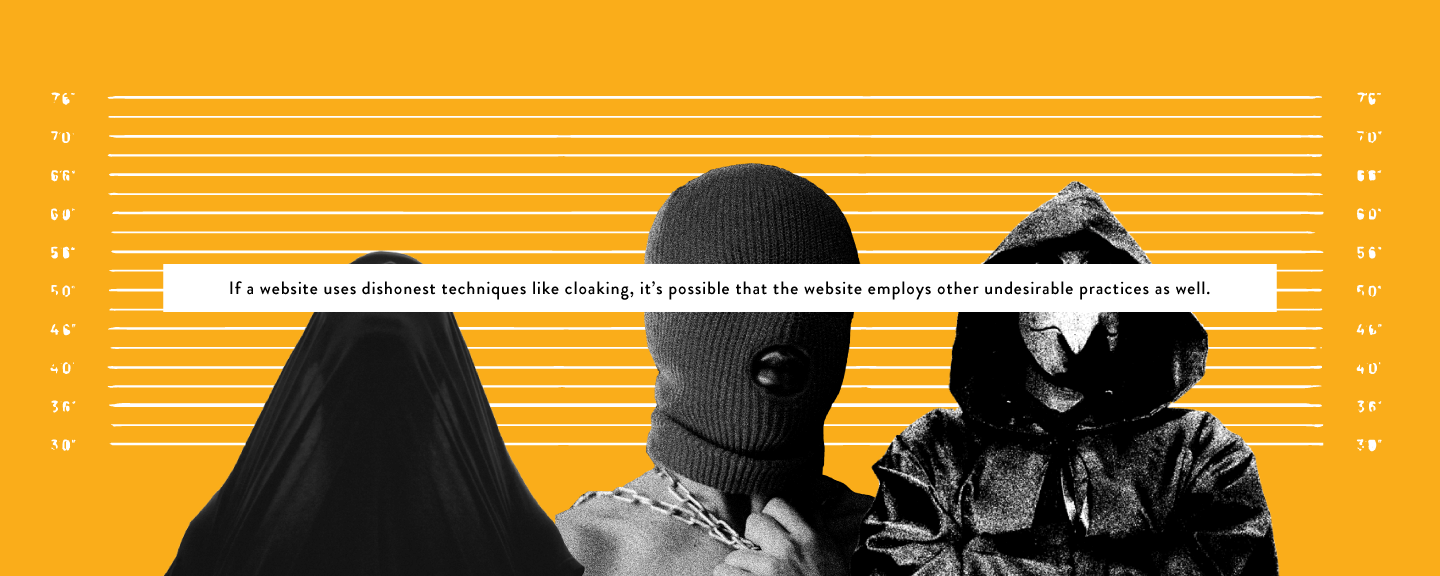What Is Cloaking in SEO?

Cloaking is a black hat SEO technique that presents different web page content to users than search engine crawlers. The purpose of cloaking is to trick the search engine’s ranking evaluation. With cloaking, the version a website shows to search engines appears to have more value and keyword relevance than the “real” version served to human visitors.

As with most SEO strategies, the ultimate goal of this tactic is to get a page to rank highly on the search engine results page (SERP). However, this deceptive practice misrepresents the page’s content and seeks to take advantage of search engine algorithms and indexing mechanisms to boost the page’s keyword rankings.
As with other black hat SEO tactics, this practice goes against Google’s spam policies and has the potential to get a site penalized. However, there are some situations where cloaking happens inadvertently, so it’s important to recognize these situations and take steps to avoid potential penalties.
Cloaking Practices
There are several techniques for cloaking. These methods can range from hiding a few elements from users to serving up an entirely different batch of content.
- Cloaked redirect: While redirection can be a useful tool for webmasters to preserve the value of links or old, popular pages following a site restructure, it can also be a means of cloaking. A cloaked redirect sends visitors to a different page while displaying a falsified URL to mask the fact that they’re redirected.
- Hidden text: In some cases, a page can be stuffed with keywords that are invisible to a user. The text might be the same color as the background, or the site renders the text invisible through coding.
- User-agent detection: In this technique, a website uses a server-side script or another technical method to determine whether a site visitor is a real human or a search engine crawler. This will determine which page the site provides to the viewer.
Though the techniques may differ, they all share the quality of deceiving users and search engines.
Why Cloaking Is A Bad SEO Strategy
Cloaking is a deceptive practice with no real benefits for site visitors, search engines, or the site’s webmaster.
Humans using search want to find a page that matches their search intent and expectations, and search engines want to deliver their users the page that best matches their query. Cloaking elements of your page, or serving an entirely different page, ensures both sides will be disappointed.
You may see short-term benefits in search traffic, but when search engines eventually detect your use of cloaking, the page will be penalized or even excluded from the search index. And you’re serving a bad experience to your site visitors if the content they find is not what they were actually searching for.
If a page is replaced as part of a restructuring, a redirect can help preserve some of the link equity of that older page. It will still be important to pursue a fresh link building strategy to ensure the new/replacement/updated page can earn links and be recognized for what it has become.
Ultimately, cloaking is a bad SEO tactic because it creates incredible risk for, at best, short-term gains.
Identifying Cloaking

If a website uses dishonest techniques like cloaking, it’s possible that the website employs other undesirable practices as well. Additionally, if your own page has signs of cloaking, you’ll want to be able to identify and understand why. There are instances where your site could be hacked, with cloaked links added to pass link equity to the hacker’s site, using cloaking methods to make it harder to identify the cloaked links.
There are a couple of methods for identifying a cloaked page.
- Use a cloaking checker: Services such as SmallSEOTools or Dupli Checker offer a way to check URLs for cloaked elements.
- Compare content on the page and on the SERP: Look for differences between the page you access and its brief description on the SERP. If there are major discrepancies, it’s likely the page is cloaking.
It’s possible that cloaking will also be accompanied by other black hat SEO practices. For instance, finding black hat SEO practices like keyword stuffing could be a hint that you should check for cloaking as well.
Alternatives to Cloaking
Though the practice of cloaking is shady, it is often done with the philosophy that the ends justify the means.
However, the results will be short-lived at best and lead to bad long-term outcomes – notably being penalized and removed from the search index.
Whether intentionally or unintentionally cloaking, we recommend:
- Focus on search engine accessibility: Search engines struggle to effectively crawl and understand some types of pages, such as image galleries. In these cases, adding elements like alt text helps crawlers better understand the contents of the page, removing the need to cloak the page with a keyword-rich alternative.
- Create unique and quality content: Rather than try to trick search engines into thinking your content is more valuable than it is, the best policy is to provide content that is useful to readers and follow on-page SEO best practices.
- Optimize pages for mobile: Google makes an exception for redirecting to a mobile subdomain. In these cases, offering a mobile-optimized version of a page can be a good alternative to cloaking.
- Optimize pages for local search: Some sites find they struggle to rank locally, particularly in a competitive market, and as a result, turn to cloaking. However, knowing how to optimize a page for local search can help you avoid this. Boost local traffic by focusing on things like Google My Business and performing a site-wide SEO audit.
Take these considerations to heart, and you’ll find it’s possible to give users a page that is useful while simultaneously indicating its contents and value to search engines like Google.
How To Avoid Cloaking

People may perform some cloaking methods accidentally or with good intentions. Still, they can result in search engine penalties.
Check your site’s code for hidden text, either in the HTML code or in JavaScript. Ensure the page’s CSS doesn’t conceal text. Additionally, make sure any redirects happen for legitimate purposes, such as a 301 or 302 redirection.
How To Reverse Cloaking Efforts
Whether you have been cloaking on purpose or inadvertently, the best route is to reverse these practices.
- Identify cloaked pages: Review your website for pages that have cloaked elements, and make a list.
- Remove server-side scripts: Check for any server-side scripts that serve to detect user agents or provide different content to users and crawl bots.
- Re-evaluate SEO strategy: Examine your SEO strategy, and ensure that you engage only in white hat SEO practices.
- File a reconsideration request: If your page has been removed from the search index due to cloaking, submit a reconsideration request after fixing the issues.
Keeping up to date on SEO best practices will help you avoid using any practices like cloaking that can result in a penalty from search engines.
